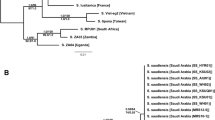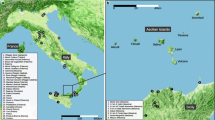Abstract
Studies have revealed that the
genus Pheidole (Formicidae: Myrmicinae) is the most diverse group of ants and highly distributed around the globe. Species delimitation through DNA-based approaches has lately received increased attention to overcome the taxonomic hurdle. This study reassessed the morphology and barcode Pheidole rugaticeps Emery and Pheidole decarinata Santschi collected in Nigeria. P. rugaticeps and P. decarinata are the most abundant ant species in the area sampled. Taxonomy of both Pheidole spp were reassessed using morphometrics. The morphological diagnosis of the worker castes was consistent with P. rugaticeps Emery, 1877 specimen (CASENT0281618), and P. decarinata Santschi specimen (CASENT0913301) from AntWeb.org. For the DNA-based identification, LCO1490/HCO2198 and LepF1/LepR1 primer pairs that consistently amplified a 710-bp fragment of Cytochrome oxidase subunit 1 (CO1) of invertebrates were used. The Basic Local Alignment Search Tool (BLAST) program of the NCBI database was used to confirm the genus as Pheidole. However, the species identity produced less than 90% match with the available CO1 sequences in the database. DNA sequences of P. rugaticeps and P. decarinata were not previously submitted at NCBI or other online databases. Hence, DNA sequences of P. rugaticeps (accession no; MT309805) and P. decarinata (accession no; MT308581) were added to the NCBI database for the first time and will be additional diagnostic tools for future studies. The phylogenetic result suggested that both Pheidole species were distinct. The study encourages the combination of morphological and molecular practices to identify this diverse ant group.






Similar content being viewed by others
References
AntWeb (2020) Pheidole decarinata Santschi, 1929. https://www.antweb.org/description.do?name=decarinata&genus=Pheidole&rank=species. Accessed 22 October 2020
Arnold G (1960). New species of African Hymenoptera. No. 15. Occasional Papers of The National Museum of Southern Rhodesia 3 (No. 24B): 452–488
Belshaw R, Bolton B (1993) The effect of forest disturbance on the leaf litter ant fauna in Ghana. Biodivers Conserv 2:656–666. https://doi.org/10.1007/BF00051965
Bernard F (1953) La réserve naturelle intégrale du Mt Nimba. XI. Hyménoptères Formicidae. Mémoires de l'Institut Français d'Afrique Noire 19: 105
Bolton (2020) An Online Catalog of the Ants of the World. Retrieved from https://www.antcat.org/catalog/429833
Bolton B (1994) Identification Guide to the Ant Genera of the World. Harvard University Press
Borowiec L (2014) Catalog of ants of Europe, the Mediterranean Basin, and adjacent regions (Hymenoptera: Formicidae). Genus (wroclaw) 25(1–2):1–340
Borowiec L, Salata S (2018) Notes on ants (Hymenoptera: Formicidae) from Gambia (Western Africa). Annals of the Upper Silesian Museum in Bytom Entomology 27:1–13. https://doi.org/10.5281/zenodo.1481794.Accessed 22 October 2020
Collingwood CA, Agosti D (1996) Formicidae (Insects: Hymenoptera) of Saudi Arabia (Part 2). Fauna of Saudi Arabia 15:300–385
Deblauwe I, Dekoninck W (2007) Diversity and distribution of ground-dwelling ants in a lowland rainforest in southeast Cameroon. Insectes Soc 54:334–342. https://doi.org/10.1007/s00040-007-0951-8
Diame L, Taylor B, Blatrix R, Vayssieres JF, Rey JY, Grechi I, Diarra K (2017) A preliminary checklist of the ant (Hymenoptera, Formicidae) fauna of Senegal. Journal of Insect Biodiversity 5(15):1–16
Dolezal AG (2019) Caste determination in arthropods. In Encyclopedia of Animal Behavior (2nd edn, Vol. 4). https://doi.org/10.1016/B978-0-12-809633-8.20815-7
Eguchi K, Bui TV (2005) A new South Vietnamese species of the genus Pheidole with a truncated head in the major and queen. Sociobiology 45:721–730
Eguchi K (2000) Two new Pheidole species with a 5-segmented antennal club. Entomological Science 3:687–692
Eguchi K (2001a) A revision of the Bornean species of the ant genus Pheidole. Tropics 2:1–155
Eguchi K (2001b) A taxonomic study on Asian Pheidole (Hymenoptera, Formicidae): New synonymy, rank Changes, lectotype designations, and redescriptions. Insecta Koreana 18:1–35
Eguchi K (2008) A revision of Northern Vietnamese species of the ant genus Pheidole. Zootaxa 1902:1–118
Eguchi K, Yamane S, Zhou SY (2007) Taxonomic revision of the Pheidole rinae Emery complex. Sociobiology 50:257–284
Emery C (1877) Catalog of the ants existing in the collections of the Civic Museum of Genoa. Part one. Ants from the journey of the Antinori, Beccari and Issel lords in the Red Sea and in the land of the Bogos [concluded]. Annals of the Civic Museum of Natural History 9:369–381
Fischer G, Garcia FH, Peters MK (2012) Taxonomy of the ant genus Pheidole Westwood (Hymenoptera: Formicidae) in the Afrotropical zoogeographic region: Definition of species groups and systematic revision of the Pheidole pulchella group. Zootaxa, 3232(1):1–43. https://doi.org/10.11646/zootaxa.3232.1.1
Fisher BL (2004) Diversity patterns of ants (Hymenoptera: Formicidae) along an elevational gradient on Monts Doudou in Southwestern Gabon. California Academy of Sciences Memoir 28:269–286
Fournier D, De Biseau JC, Aron S (2009) Genetics, behaviour and chemical recognition of the invading ant Pheidole megacephala. Mol Ecol 18:186–199. https://doi.org/10.1111/j.1365-294X.2008.04018x
Hita Garcia F, Fischer G, Peters MK, Wägele JW (2009) A preliminary checklist of the ants (Hymenoptera: Formicidae) of Kakamega Forest (Kenya). J East Afr Nat Hist 98:147–165. https://doi.org/10.2982/028.098.0201
Hölldobler B, Wilson EO (1990) The ants. Harvard University Press, Cambridge
Kumar S, Stecher G, Tamura K (2016) MEGA7: Molecular Evolutionary Genetics Analysis version 7.0 for bigger datasets. Mol Biol Evol 33:1870–1874
Lin X, Stur E, Ekrem T (2015) Exploring genetic divergence in a species-Rich insect genus using 2790 DNA barcodes. PLoS ONE 10:e0138993
Longino JT (2009) Additions to the taxonomy of New World Pheidole (Hymenoptera: Formicidae). Zootaxa 2181(2181):1–90. https://doi.org/10.11646/zootaxa.2181.1.1
Madl M (2019) Notes on the ant fauna of Eritrea (Insecta: Hymenoptera: Formicidae): type specimens deposited in the Natural History Museum Vienna (Austria) and a preliminary checklist. Annalen Des Naturhistorischen Museums in Wien B 121:9–18
Menozzi C (1926) Central African ants. Bulletin of the Italian Entomological Society 58:36–41
Menozzi C (1930) Ants from southern Italian Somalia. Memoirs of the Italian Entomological Society 9:76–130
Mora C, Tittensor DP, Adl S, Simpson AGB, Worm B (2011) How Many Species Are There on Earth and in the Ocean? PLoS Biol 9(8):e1001127. https://doi.org/10.1371/journal.pbio.1001127
Moreau CS (2008) Unraveling the evolutionary history of the hyperdiverse ant genus Pheidole (Hymenoptera: Formicidae). Mol Phylogenet Evol 48(1):224–239. https://doi.org/10.1016/j.ympev.2008.02.020
Nei M, Kumar S (2000) Molecular evolution and phylogenetics. Oxford university press
Ng’endo RN, Osiemo ZB, Brandl R (2013) DNA barcodes for species identification in the hyperdiverse ant genus Pheidole (Formicidae: Myrmicinae). Journal of Insect Science (online) 13:27. https://doi.org/10.1673/031.013.2701
Rozas J, Ferrer-Mata A, Sánchez-DelBarrio JC, Guirao-Rico S, Librado P, Ramos-Onsins SE, Sánchez-Gracia A (2017) DnaSP 6: DNA Sequence Polymorphism Analysis of Large Data Sets. Mol Biol Evol 34(12):3299–3302. https://doi.org/10.1093/molbev/msx248
Saitou N, Nei M (1987) The neighbor-joining method: A new method for reconstructing phylogenetic trees. Mol Biol Evol 4:406–425
Salata S, Fisher BL (2020) Pheidole Westwood, 1839 (Hymenoptera, Formicidae) of Madagascar – an introduction and a taxonomic revision of eleven species groups. ZooKeys 905:1–235. https://doi.org/10.3897/zookeys.905.39592
Santschi F (1929) Mélange Myrmécologique Wien Entomol Ztg 46:84–93
Santschi F (1914) Formicides de l’Afrique occidentale et australe du voyage de Mr. le Professeur F. Silvestri. Bollettino del Laboratorio di Zoologia Generale e Agraria della Reale Scuola Superiore d’Agricoltura. Portici 8:309–385
Sarnat EM (2008) A taxonomic revision of the Pheidole roosevelti-group (Hymenoptera: Formicidae) in Fiji. Zootaxa 1767:1–36
Sarnat EM, Moreau CS (2011) Biogeography and morphological evolution in a Pacific island ant radiation. Mol Ecol 20(1):114–130. https://doi.org/10.1111/j.1365-294X.2010.04916.x
Sarnat EM, Fischer G, Guénard B (2015) Economo EP (2015) Introduced Pheidole of the world: Taxonomy, biology and distribution. ZooKeys 543:1–109. https://doi.org/10.3897/zookeys.543.6050
Schmidt AM, d’Ettorre P, Pedersen JS (2010) Low levels of nestmate discrimination despite high genetic differentiation in the invasive pharaoh ant. Front Zool 7:20. https://doi.org/10.1186/1742-9994-7-20
Sharaf MR, Fisher BL, Al Dhafer HM, Polaszek A, Aldawood AS (2018) Additions to the ant fauna (Hymenoptera: Formicidae) of Oman: an updated list, new records and a description of two new species. Asian Myrmecology 10:e010004
Sylvanus CE, Badejo MA, Ajayi OO (1997) Ants of forest and fallow plots in Nigeria. Biotropica 29(1):93–99
Szalanski AL, McKern JA, Solorzano C, Austin JW (2010) Genetic Diversity of Ants (Hymenoptera: Formicidae) from the Ozark-St. Francis National Forest, Arkansas, USA. Sociobiology 56:1–10
Taylor B (2020). The Ants of Africa, Genus Pheidole, Pheidole decarinata Santschi. http://antsofafrica.org/ant_species_2012/pheidole/pheidole_decarinata/pheidole_decarinata.htm. Accessed 22 October 2020
Taylor B (1976) Ants of the Nigerian Forest Zone (Hymenoptera: Formicidae). I. Ponerinae, Cerapachyinae, Pseudomyrmecinae. Cocoa Research Institute of Nigeria Technical Bulletin Series 4:1–41
Taylor B (1978) Ants of the Nigerian Forest Zone (Hymenoptera: Formicidae). II. Formicinae, Dolichoderinae. Cocoa Research Institute of Nigeria Research Bulletin 5:1–57
Taylor B (1979) Ants of the Nigerian Forest Zone (Hymenoptera: Formicidae). III. Myrmicinae (Cardiocondylini to Meranoplini). Cocoa Research Institute of Nigeria Research Bulletin 6:1–65
Taylor B (1980a) Ants of the Nigerian Forest Zone (Hymenoptera: Formicidae). IV. Myrmicinae (Myrmecinini to Tetramoriini). Cocoa Research Institute of Nigeria Research Bulletin 7:1–63
Taylor B (1980b) Ants of the Nigerian Forest Zone (Hymenoptera: Formicidae). V. Dorylinae, Leptanillinae. Cocoa Research Institute of Nigeria Research Bulletin 8:1–33
Taylor B, Yefremova ZA, Kravchenko VD, Muller GC (2016) The ants of Mali (Hymenoptera: Formicidae) - a historical review and new records. Entomofauna 37(35):545–564
Thompson JD, Higgins DG, Gibson TJ (1994) CLUSTAL W: improving the sensitivity of progressive multiple sequence alignment through sequence weighting, position-specific gap penalties and weight matrix choice. Nucleic Acids Res 22:4673–4680
Ward PS (2000) Broad-scale patterns of diversity in leaf-litter ant communities. In D. Agosti, D., Majer, J. D., Alonso, L. E., & Schultz, T. R. (Eds.), Ants: Standard methods for measuring and monitoring biodiversity. Smithsonian Institution Press, Washington, pp. 99–121
Wetterer JK (2012) Worldwide spread of the African big-headed ant, Pheidole megacephala (Hymenoptera: Formicidae). Myrmecological News 17:51–62
Wheeler WM (1922) Ants of the American Museum Congo expedition. A contribution to the myrmecology of Africa. IX. A synonymic list of the ants of the Malagasy region. Bulletin of the American Museum of Natural History 1005–1055
Wilson EO (1984) Tropical social parasites in the ant genus Pheidole, with an analysis of the anatomical parasite syndrome. Insectes Soc 31:316–334
Wilson EO (2003) Pheidole in the new world: A dominant, hyperdiverse ant genus. Rev Biol Trop 53(1–2):297–304
Acknowledgements
This research was funded under the Universiti Sains Malaysia (USM) Bridging Fund (304/PBIOLOGI/6316510)
Author information
Authors and Affiliations
Corresponding author
Ethics declarations
Conflicts of Interest
The authors declare no conflict of interest.
Rights and permissions
About this article
Cite this article
Ashigar, M.A., Ab Majid, A.H. Morphological reassessments and DNA barcoding of Pheidole rugaticeps Emery and Pheidole decarinata Santschi collected in Nigeria. Int J Trop Insect Sci 42, 403–413 (2022). https://doi.org/10.1007/s42690-021-00557-w
Received:
Accepted:
Published:
Issue Date:
DOI: https://doi.org/10.1007/s42690-021-00557-w




